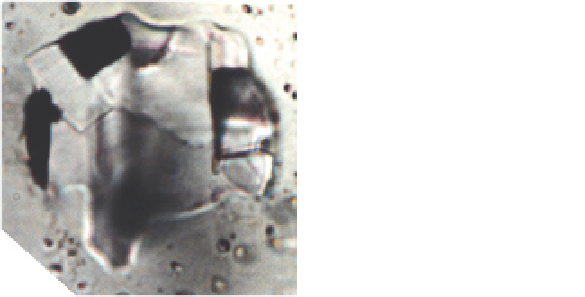Geoscience Reference
In-Depth Information
a
b
d
c
e
20
o
C
580
o
C
680
o
C
g
f
o
p
p
c
c
ca ca
ca
c
o
o
Fig. 8. Photomicrographs of (a) groundmass olivine and (b-g) olivine-hosted melt
inclusions. Scale bars represent 50 µm. B: Multiphase melt inclusion hosted in core of olivine
(boxed in a). c: Typical melt inclusion at room temperature. d: Same inclusion at 580
o
C
shows immiscibility between carbonate (matrix) and chloride (globules) melt. e: Same
inclusion at 680
o
C shows complete miscibility and homogenisation transmitted light). Note
sculptured surface of melt inclusion at temperature of homogenisation. f, g: Multiphase melt
inclusion in transmitted and reflected light, respectively. Principal daughter phases: c—
sodium-potassium chloride; o—olivine; p—phlogopite; ca—sodium-potassium-calcium
carbonate
4.1 Melt inclusions in groundmass olivine-II
Melt inclusions are trapped either individually within olivine cores and rims, or occur along
healed fractures (Fig. 3, 8; Golovin et al., 2003; Kamenetsky et al., 2004; Kamenetsky et al.,
2007a). Many inclusions are interconnected by thin channels, and thus modifications of
original melt compositions by “necking down” cannot be ruled out. Abundant secondary
melt inclusions in fractures connected to the groundmass, and decrepitated inclusions, are
assumed to have experienced exchange and loss of material, respectively, after entrapment.





















































Search WWH ::

Custom Search